Sunday, March 16, 2008
Teams with good spinners bat well against spin and pace.
It's useful to check the common wisdom, or things that seem obvious. Often they're true, but sometimes they're not, and even if true, sometimes an analysis reveals surprising related results. This post falls into the latter category.
If a team has good spinners, then their batsmen should do better when playing against spinners. This might be because the country generally produces lots of spinners and so batsmen grow up playing lots of them, or because the batsmen get to practice in the nets against good spinners, or some combination of the two. The same principle should apply to pace bowling.
So let's check. I went to Statsguru and got each of the top eight teams's averages against pacemen, and each team's overall pacemen's average. To start, I considered only the 2000's. The results are plotted below:
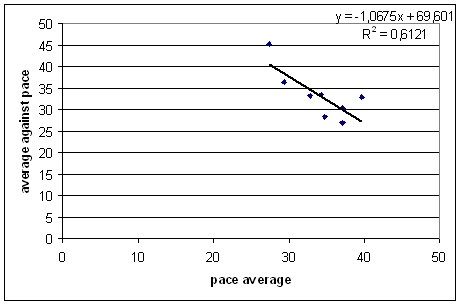
That's quite a strong trend, but the direction agrees with the common sense — teams whose pace bowlers have high averages don't score as many runs against pace bowlers, and vice versa. As I said, the trend is very strong, and much of this is due to the luck of world cricket over the past decade. Australia has had excellent batsmen and excellent pacemen, the West Indies the opposite. I repeated the exercise for earlier decades (90's, 80's, and 70's; the results for the 1960's go a bit haywire because three out of the seven teams were weak), and the direction of the trend is the same, but the magnitude varied from a slope of -0.17 to -0.8.
Still, a verification of what we thought we knew, and some ideas of how strong the effect is. Now let's do the same for spinners.
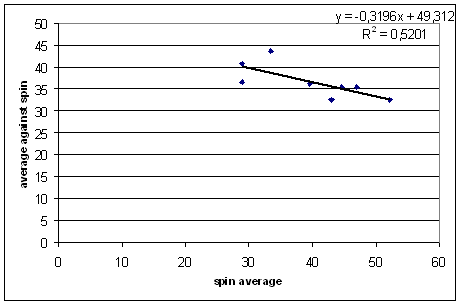
The same basic trend, though with a gentler slope. The results for the earlier decades are similar, with the slopes ranging from -0.3 (the one shown above) to -0.75.
Now let's see if we can get null results. If a team has good pacemen, that should tell us nothing about how well they play spin, right?
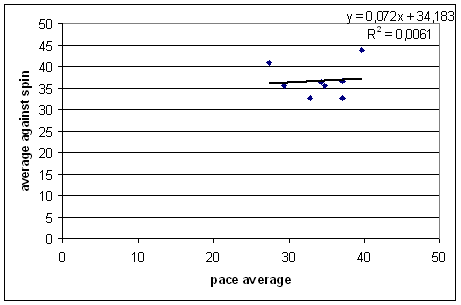
Right. No trend at all.
Similarly, if a team has good spinners, that should tell us nothing about how they play pace.
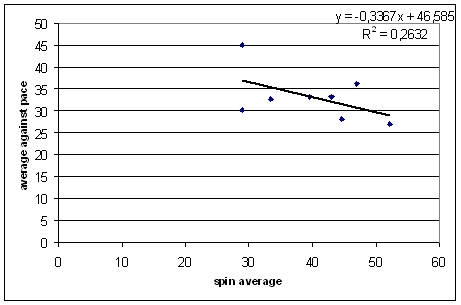
Erm, wrong. Teams with good spinners tend to play pace well. The same trend exists for the earlier decades, with slopes ranging from -0.18 to -0.33 (above). I don't know what the p-value is, but it looks like it's not just luck.
I don't know how to explain this. I have two ideas:
1) learning how to play high-quality spin makes you a better batsman in general;
2) spinners with good pacemen in the team do better than those without, and so the trend is really just "average against pace" v "pace average" in disguise.
I'm inclined to think that the second of these two ideas is a strong factor, but there's no correlation between spin average and pace average in either of the last two decades. For the 2000's:
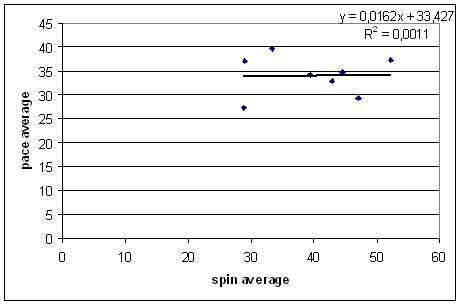
For the 1980's and 1970's, there is a positive correlation between the two.
From my post on bowler support, a useful rule of thumb in dealing with aggregated data like this is that for every run lower a bowler's teammates' bowling averages are, the bowler's average should go down by a quarter of a run. This works pretty well for the 1980's and 1970's graphs, but doesn't help explain what's going on in the last two decades.
It's a bit of a puzzle, and I don't know what the answer is. Teams that have good spinners tend to play pace well.
(A post-script: I was going to do another post on captaincy today, based on some suggestions from The Atheist, but my regression failed rather miserably. I'll have another try later.)
If a team has good spinners, then their batsmen should do better when playing against spinners. This might be because the country generally produces lots of spinners and so batsmen grow up playing lots of them, or because the batsmen get to practice in the nets against good spinners, or some combination of the two. The same principle should apply to pace bowling.
So let's check. I went to Statsguru and got each of the top eight teams's averages against pacemen, and each team's overall pacemen's average. To start, I considered only the 2000's. The results are plotted below:

That's quite a strong trend, but the direction agrees with the common sense — teams whose pace bowlers have high averages don't score as many runs against pace bowlers, and vice versa. As I said, the trend is very strong, and much of this is due to the luck of world cricket over the past decade. Australia has had excellent batsmen and excellent pacemen, the West Indies the opposite. I repeated the exercise for earlier decades (90's, 80's, and 70's; the results for the 1960's go a bit haywire because three out of the seven teams were weak), and the direction of the trend is the same, but the magnitude varied from a slope of -0.17 to -0.8.
Still, a verification of what we thought we knew, and some ideas of how strong the effect is. Now let's do the same for spinners.

The same basic trend, though with a gentler slope. The results for the earlier decades are similar, with the slopes ranging from -0.3 (the one shown above) to -0.75.
Now let's see if we can get null results. If a team has good pacemen, that should tell us nothing about how well they play spin, right?

Right. No trend at all.
Similarly, if a team has good spinners, that should tell us nothing about how they play pace.

Erm, wrong. Teams with good spinners tend to play pace well. The same trend exists for the earlier decades, with slopes ranging from -0.18 to -0.33 (above). I don't know what the p-value is, but it looks like it's not just luck.
I don't know how to explain this. I have two ideas:
1) learning how to play high-quality spin makes you a better batsman in general;
2) spinners with good pacemen in the team do better than those without, and so the trend is really just "average against pace" v "pace average" in disguise.
I'm inclined to think that the second of these two ideas is a strong factor, but there's no correlation between spin average and pace average in either of the last two decades. For the 2000's:

For the 1980's and 1970's, there is a positive correlation between the two.
From my post on bowler support, a useful rule of thumb in dealing with aggregated data like this is that for every run lower a bowler's teammates' bowling averages are, the bowler's average should go down by a quarter of a run. This works pretty well for the 1980's and 1970's graphs, but doesn't help explain what's going on in the last two decades.
It's a bit of a puzzle, and I don't know what the answer is. Teams that have good spinners tend to play pace well.
(A post-script: I was going to do another post on captaincy today, based on some suggestions from The Atheist, but my regression failed rather miserably. I'll have another try later.)
Comments:
<< Home
I assume that the top 8 teams since 2000, includes India.
The common perception is Indians do not play pace well.
If so it is a revelation that Indians play pace well.
The common perception is Indians do not play pace well.
If so it is a revelation that Indians play pace well.
It's just a trend - the correlation isn't perfect. In terms of averages since 2000, India rank third in terms of their spinners, and fifth in how well they place pace.
Pakistan I think should be an outlier here. They have produced amazing spinners - Qadir, Mushtaq, Saqlain, and Kaneria to some extent, yet mediocre spinners like Giles and Paul Harris have run through Paki batting line ups.
Same goes for pace -Pak has probably produced the best fast bowlers for as long time, yet their batsmen have crumbled in front of genuice pace bowlers.
??? Mind boggling :-)
Same goes for pace -Pak has probably produced the best fast bowlers for as long time, yet their batsmen have crumbled in front of genuice pace bowlers.
??? Mind boggling :-)
Pakistan are not outlier-ish at all, in fact. Taking 1980-present (which should cover all the bowlers you mentioned), they are ranked third in terms of their pacemen's averages, and third in terms of how well they play pace. It's fourth and fourth for spin.
Bear in mind that this doesn't measure how well they do against the really good pacemen or spinners, just how they do overall against them. And while Warne and Giles have done better against Pakistan than they do against most other teams, look at some other players - Harbhajan and Maninder Singh both average around 50.
Bear in mind that this doesn't measure how well they do against the really good pacemen or spinners, just how they do overall against them. And while Warne and Giles have done better against Pakistan than they do against most other teams, look at some other players - Harbhajan and Maninder Singh both average around 50.
I think who the spinners and pacemen are is also worth questioning. The Australians don't face Warne and the Sri Lankans don't face Murali. Similarly, the Australians don't face their pace attack (the strongest in the world for much of this decade), while the Indian batsmen don't get to face their own.
In the current Test match cycle for example, only Pakistan and West Indies concede more runs for each wicket they take in Home Tests than India. When India play away from home (where pace bowling is important), they concede 37 runs/wicket, while they score 32, which is about par.
The importance of this is, that with a strong bowling attack, batting sides are under less pressure and in the lead more easily - runs are easier to come by when a side is in the lead than when they face a deficit.
Good to see someone else interested in stats though.... it's rare :)
In the current Test match cycle for example, only Pakistan and West Indies concede more runs for each wicket they take in Home Tests than India. When India play away from home (where pace bowling is important), they concede 37 runs/wicket, while they score 32, which is about par.
The importance of this is, that with a strong bowling attack, batting sides are under less pressure and in the lead more easily - runs are easier to come by when a side is in the lead than when they face a deficit.
Good to see someone else interested in stats though.... it's rare :)
Kartikeya, that's a good point about Australians not facing their bowlers, and Sri Lankans not facing Murali, etc.
I went back and adjusted each team's averages to account for this, and the trends remain, but they are not quite as strong as the ones in this blog post.
In particular, there was no trend at all for the pace-pace graph in the 1990's (slope -0.02), though for the other decades it's still there, with the slope of the regression curve ranging from -0.26 to -0.91. For spin-spin, it goes from -0.16 to -0.70.
The other two don't change much - the bizarre thing of the teams with good spinners batting well against pace remains, slopes ranging from -0.16 to -0.34.
You're also right about the "batting under pressure" factor. That'd take quite a bit more work to adjust for though.
I went back and adjusted each team's averages to account for this, and the trends remain, but they are not quite as strong as the ones in this blog post.
In particular, there was no trend at all for the pace-pace graph in the 1990's (slope -0.02), though for the other decades it's still there, with the slope of the regression curve ranging from -0.26 to -0.91. For spin-spin, it goes from -0.16 to -0.70.
The other two don't change much - the bizarre thing of the teams with good spinners batting well against pace remains, slopes ranging from -0.16 to -0.34.
You're also right about the "batting under pressure" factor. That'd take quite a bit more work to adjust for though.
Hey man, don't worry. I had a lot of nightmares with regression during my university days. I'm impressed that you tried it; I'm not even sure if it would work.
I would be very interested to see any results though.
I would be very interested to see any results though.
Isn't the sample size a bit small? I think using first class teams as an indicator (Say Ranji Trophy elite teams, or the top division of the County Championship, over say five seasons) might throw up some interesting stuff... Will be a tad difficult, I guess.
@ Ottayan
Since 2000, Indian batsmen have done very well against pace, and they simply don't fit that common perception anymore.
Post a Comment
@ Ottayan
Since 2000, Indian batsmen have done very well against pace, and they simply don't fit that common perception anymore.
Subscribe to Post Comments [Atom]
<< Home
Subscribe to Comments [Atom]
